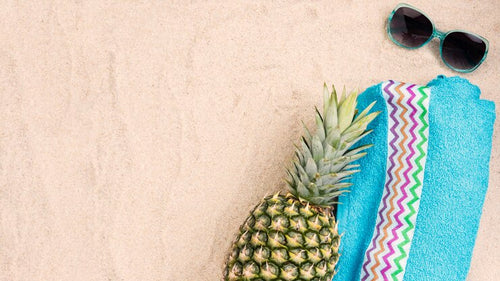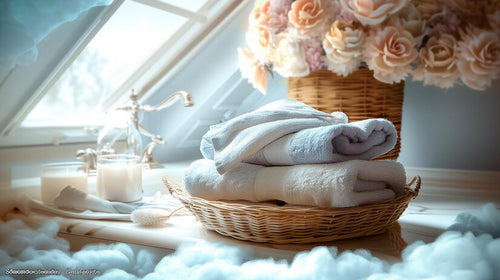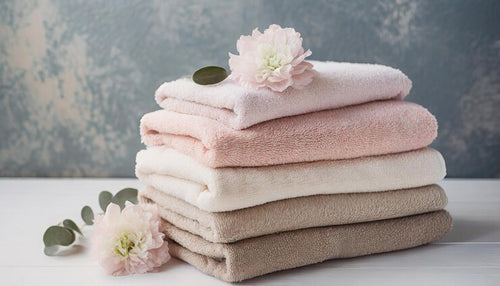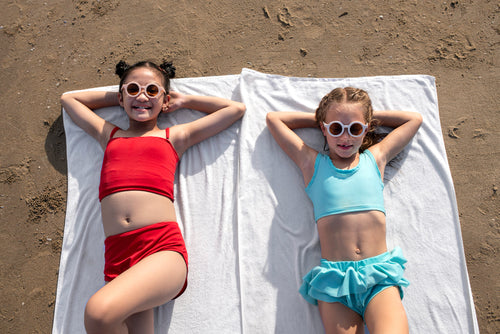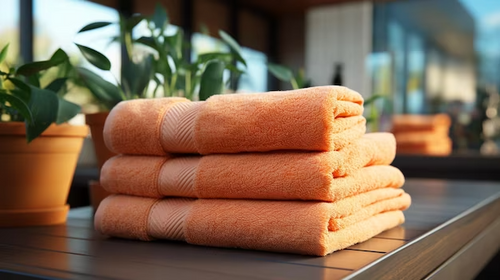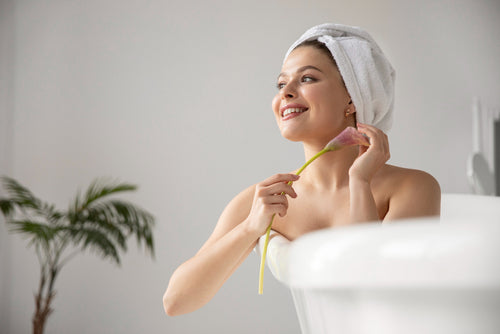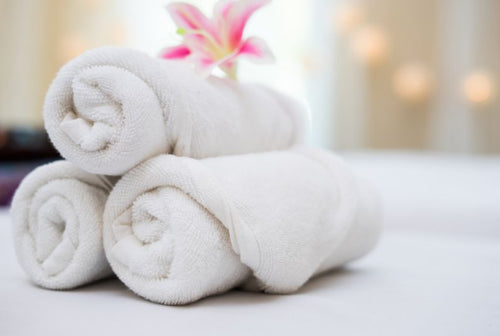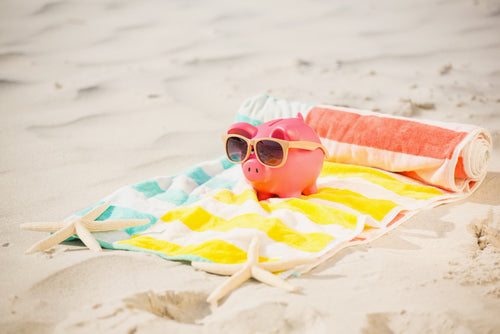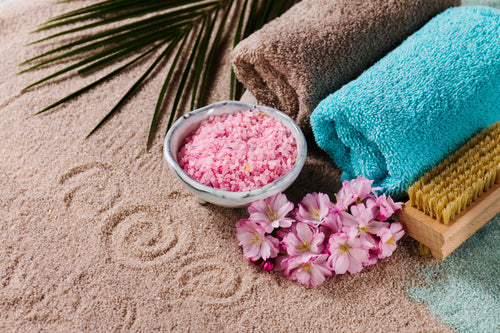For new parents, all their baby’s first are either exciting or scary enough to set their hearts racing. Similarly, while the first smile is a moment of pure joy, the baby's first bath feels nothing short of a battle. But it doesn’t have to be the case!
With this ultimate guide to your baby’s first bath, we’ll equip you with all the necessary knowledge to make this experience easy as well as memorable. From the right baby gears to the perfect water temperature, we’ve got everything.
Before we get to the step-by-step guide, we’ll start off with some general, but critical information, as your little one requires the utmost care right now to avoid any complications.
TABLE OF CONTENTS:
- When should a newborn have its first bath?
- Benefits of Delaying Baby First Bath
- The Step by Step Guide to Baby First Bath
- Important Points to Remember
- FAQs
When should a newborn have its first bath?
Sometimes, some parents are in a rush to give their newborn its first bath, in the hopes that it’ll keep the baby clean, and far from diseases, and bacteria. However, the truth is a little different.
1. In the Hospital
If you had your baby in a hospital, right after the delivery, the nurse would’ve brought your baby to you after a simple wipe down to clean away any excess blood, and amniotic fluid. To be very honest with you, that’s all your baby needs at this point. There are two reasons for this.
Firstly, you might have noticed a thin, creamy layer on the baby. This layer, the vernix caseosa, might not seem very clean, but it actually is vital and serves a very important purpose. It is nature's own version of a cleanser, moisturizer, and shield from infections, and harmful bacteria. Moreover, it also helps in regulating body warmth, which brings us to the next point.

Secondly, a newborn can't regulate its body temperature, which is why we have to take care of it for them. During those initial few days, the baby has to stay warm and cozy as they can easily catch a cold and fall sick. Therefore, the bathwater temperature, even if it's off by a few degrees, can be dangerous.
Besides that, some parents insist that their baby has its first bath in the hospital so that they can learn from more experienced people. However, based on the reasons mentioned above, it is generally advisable that you delay your baby's first bath, even in the hospital.
While the World Health Organization (WHO) suggests you wait for a full 24 hours, the norm is closer to somewhere between four and eight hours.
2. At Home
Once you’ve brought your little one home, you might be tempted to bathe them after a few diaper changes. However, again, you need to delay it. This time till the baby’s umbilical cord stump has fallen off, and the area has properly healed. This usually takes somewhere between one and three weeks.
In the meantime, you can clean your baby through sponge baths or use a damp towel such as the Mizu Towel, which is a gentle bacteria-fighting towel. One popular method is the ‘top and tail bath.’ It involves cleaning the main areas, such as the face, neck, hands, and genitals.

You have to start from the eyes, one by one and with a clean cloth each time. Then, you move on to the rest of the face, ears, and so on. Be careful to clean all creases in the skin, such as behind the knees or between the fingers.
The ‘top and tail bath’ is a good alternative for the proper baby first bath as you can do most of it without undressing your baby completely. Your baby isn’t at risk of catching a cold either.
Benefits of Delaying Baby First Bath
Besides the benefits already mentioned, such as preserving the natural layer which protects and keeps the baby warm, there are several other benefits to delaying your baby’s first bath.
● More Mother-Child Bonding Time
By delaying that first bath, the mother and baby have more time together to spend with each other. Through that skin-to-skin contact, the mother can learn her baby’s signals for better and more effective communication in the long run.
● Better In-Hospital Breastfeeding Rates
According to one study done by the Boston Medical Center, babies whose first baths were delayed showed improvements in breastfeeding rates. This further strengthens the mother-child bond, and the baby is able to benefit from the mother’s breast milk.
The Step by Step Guide to Baby First Bath
Now that significant time has passed, and your baby is ready for that first bath, it’s time you get ready as well.
1- Pre-Bath Preparations
You can never be too prepared for your baby’s first bath and don’t want to be underprepared with a slippery infant in your hands. Nevertheless, this simple list should ensure that you have everything you need for a smooth baby first bath.
Rather than running here and there with a soapy baby and trying to grab things with one hand during the bath, it’s best to gather everything you need beforehand and place them within easy reach. Here are some of the things you’ll need for the baby’s first bath:
● A small tub or plastic baby bath

First off, you’ll need a small tub, or basin in which you’ll bathe your child. The tub shouldn't be too big, or deep or else it’ll get harder for you to hold your baby right. Alternatively, you can use your bathroom or kitchen sink if you find that more comfortable.
● A plastic cup
Besides this tub, you should have some sort of a plastic cup or mug which you’ll use to scoop water and pour over the baby. This cup will be handy in rinsing soap or shampoo off. You can also use a simple cloth or damp baby towel to do the same job.
● Soap
It is best to wash your newborn with plain water, but if you do wish to use soap, you may use a small amount. Moreover, the soap has to be specifically for newborns as normal soaps can be too harsh on baby skin. The soap should be mild, fragrance-free, and have ingredients that don’t dry out the skin.
● Shampoo
If your baby has longer hair, you might need shampoo along with the soap to clean their hair. Similar to the soap, the shampoo should also be gentle and especially for babies. Additionally, you have to make sure to keep the shampoo suds away from the baby’s eyes.
However, to be on the safe side, the shampoo should be tear-free so as not to irritate the baby’s eyes.
● A sponge or soft towel
When cleaning your baby or rubbing in the soap, you can use a sponge or soft baby towel for the job. The keyword here is Soft, and we can’t stress this enough.
Whatever you use has to be incredibly gentle on the baby’s skin, or else your child might get agitated and bother you the next time you take him for a bath. Even using just your fingertips is enough.
● Another set of towels
Once you’ve bathed your baby, dry him off with another towel instantly. That, because even the short time between taking the baby out and drying him can be enough to catch a cold. After the baby is dry and clothed, you should wrap him up in another bigger and warm towel.
We highly recommend using a bacteria-fighting towel like the well-known Mizutowel that is one of the best baby bath towels you can find on the market today. Made using Japanese crafting method, Mizu is extremely soft and has smart features that help you keep your little one healthy!
● A fresh set of clothes and diaper
Keep the clothes and diaper close by and ready for the baby to wear as soon as possible.
● Baby lotion or cream
If your baby is suffering from any diaper rashes or discomfort, right after the bath is the perfect time to apply any baby lotion or ointment on it. Moreover, again, the lotion or cream has to be effective yet gentle on the baby’s skin.
● Thermometer
As mentioned earlier, newborns can’t regulate their body temperature. Therefore, you have to do it for them by making sure the bathwater temperature is just right. You can also use your elbow or the back of your wrist to test the temperatures if the thermometer is not available.
● Oils for the bath
You also have the option of adding any essential oils to the bathwater for a more soothing or nourishing bath. For instance, if the baby has excessively dry skin, you can add a bit of castor oil. Anyhow, it is advised that you should use plain water for bathing until your baby gets at least a month old.
Besides all this, some other preparations you can do beforehand are removing any jewelry or watches that could scratch the baby and disconnecting phones to minimize distractions. Moreover, if you want to remember the special occasion, you can set up a camera or your video recorder.
2- The Bath
With everything gathered, it’s time to start the bath now.
Step 1: Fill the tub
Fill the tub or sink with about two inches or five to ten centimeters of water. Sometimes, adding a bit more water to cover the shoulders can be relaxing for the baby. Turn the tap off once you’ve filled the tub.
Check the water temperature. Ideally, it should be around 37 to 38 degrees Celsius. If you don’t have a thermometer, use your elbow to make sure the water is neither cold nor hot. It should be warm and comfortable for the baby.
Additionally, a mistake many parents make at this stage is to warm the water, but keep the room chilly. Along with the bathwater, the bathing room should also be warm and toasty so that the baby doesn’t catch a cold as it gets out of the bath.
Step 2: Get your baby ready

Start undressing your baby and leave the diaper for the last. When he’s completely bare, position the baby securely in your hands before you insert him in the water. Hold the baby in such a way that one of your hands is supporting its head and neck throughout.
Step 3: Lower the baby in the water
With one hand holding the head and neck, and the other holding the bottom of the baby, gently insert the baby in the water. The feet should go first and then slowly the rest of the body till you can place the baby in the tub and free one hand.
Make sure your one hand is still holding up the baby’s head.
Step 4: Wash the baby
Starting with the face, begin washing your baby. Clean any gunk around its eyes, using a fresh cloth each time so as to not spread any infection from one eye to the other. Move on to his mouth and chin. Then comes the ears, and similarly, you can work your way down.
Once you’re done cleaning, make sure there is no dirt or soap left behind anywhere that could irritate the skin.
Step 5: Take the baby out and dry
At this point, the baby will be quite wet and slippery, so carefully take him out of the tub and place him on the drying table. Using a soft towel, pat the baby dry properly. Now is the time to give your baby a massage or apply any cream if you want to.
Otherwise, you should quickly dress him and wrap him up in a warm towel for some cuddling time.
Important Things to Remember
We know we made it sound pretty simple, but there are still so many things that could go wrong. Therefore, you need to be mindful of them beforehand, to avoid any mistakes.
-
Don’t prolong the bath. The water can get cold quite fast, and even five extra minutes can be enough to make your baby cold. Try to get the bathing done within five to ten minutes.
-
Make sure you get all the important places. Even if you’re trying to wrap up the bath quickly, it’s important that you properly clean all the key areas. For example, wash the face, genitals, diaper area, hands and feet, and between all the fingers, creases behind the knees and neck, under the arms, etc.
-
Don’t ever leave a toddler unattended in the bath, even for a second! We repeat, never ever leave your baby in the bath unattended even for a second. A baby can slip and drown even in shallow water, and that too, without any sound.
-
Enjoy this baby bathing time yourself. The baby will respond to how you’re feeling. If you’re calm and having fun, the baby will feel relaxed as well.
- Don’t force it! If the baby is too uncomfortable and resisting the bath, just go for simple sponge baths. Then, after a while, you can try again.
FAQs

As new parents, we’re always worried about even the littlest of things like an abnormal hiccup or excessive pooping. Similarly, there are always a million questions before we go for a baby’s first bath. Well, we’re here to answer some of those questions for you.
How often should I bathe my baby?
For newborn children, it is sufficient to bathe them two to three times a week. Since they don’t really get too dirty, you don’t often need to bathe them fully. You can do simple sponge baths in the middle if you do feel that they’ve gotten dirty.
Other than that, it also depends on how comfortable the baby is in getting a bath. Some babies might not enjoy the experience, in which case, a bath even once a week will be pretty hard. Similarly, if they do enjoy it, you can even bathe them every day.
However, for very young babies, bathing them every day can dry out their skin. So, you’ll need to strike a balance there.
What baby gear do I need for the baby first bath?
Aside from the essentials mentioned above, it’s all up to the parents how they want to enhance that baby’s first bath experience. They can add some bath toys if they wish or even a bathtub spout cover. For some, their sink, soap, and a handy Mizu Towel are all they need.
When should I bathe my baby in the day?
Again, it all depends on the parents. They can do so whenever they feel comfortable and confident in bathing their baby. For some parents, the baby’s bath is a good calming routine and a way to spend time bonding, so they do it at night. For some, the morning might be more convenient.
Other than that, a time that you shouldn't bathe your baby is right after feeding as their tummies need time to settle.
Conclusion
While a newborn can be quite stressful, any time you spend with your baby becomes a magical time. Similarly, the idea of the baby’s first bath may terrify you right now. However, with our ultimate guide, you’ll get the hang of it in no time, and you’ll be marveling at fast these babies grow and remembering their first bath.





